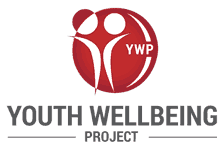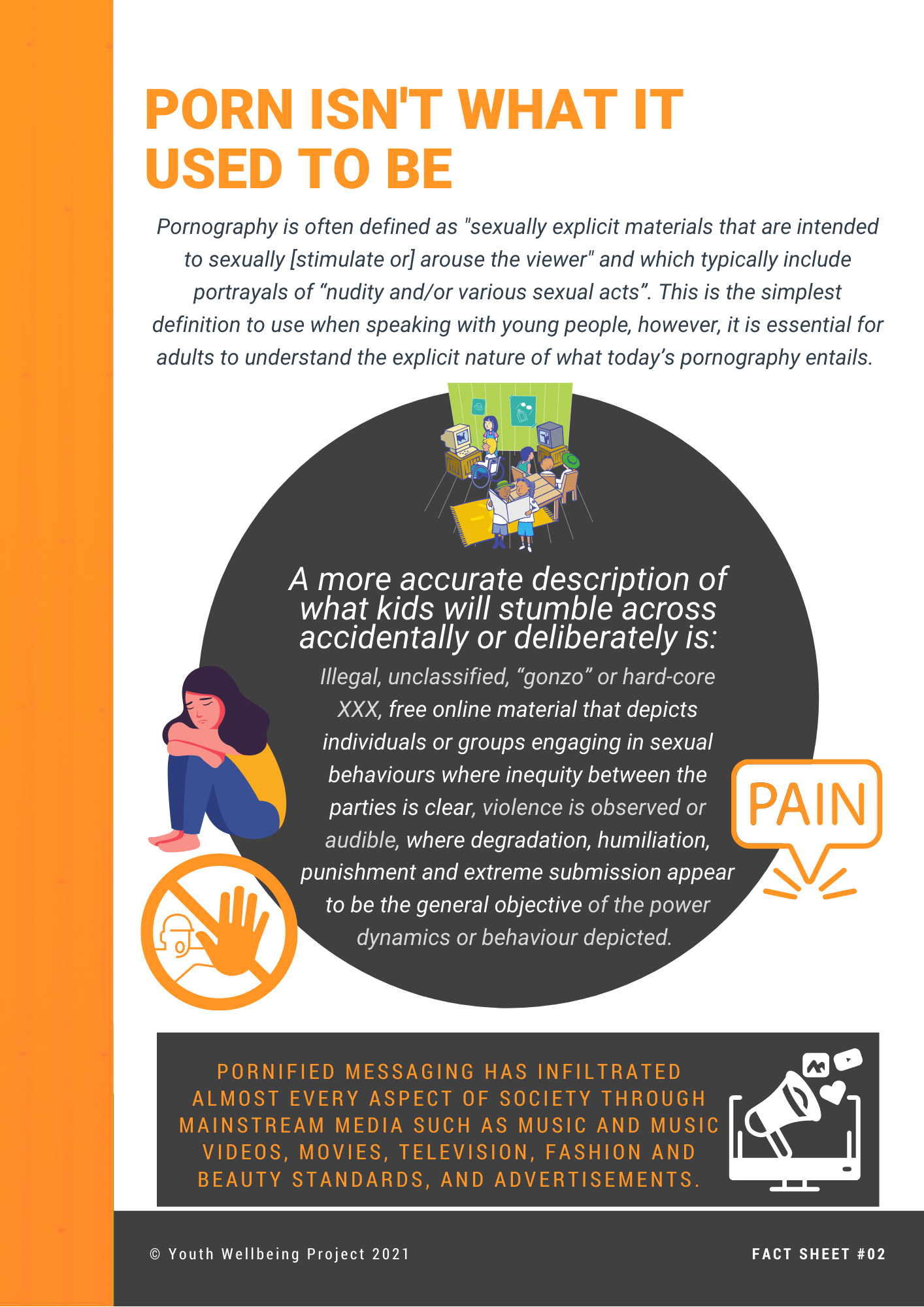Porn isn’t what it used to be
Pornography is often defined as “sexually explicit materials that are intended to sexually [stimulate or] arouse the viewer” and which typically include portrayals of “nudity and/or various sexual acts”. This is the simplest definition to use when speaking with young people, however, it is essential for adults to understand the explicit nature of what today’s pornography entails.
A more accurate description of what kids will stumble across accidentally or deliberately is: Illegal, unclassified, “gonzo” or hard-core XXX, free online material that depicts individuals or groups engaging in sexual behaviours where inequity between the parties is clear, violence is observed or audible, where degradation, humiliation, punishment and extreme submission appear to be the general objective of the power dynamics or behaviour depicted.
Pornified messaging has infiltrated almost every aspect of society through mainstream media such as music and music videos, movies, television, fashion and beauty standards, and advertisements.
YOUNG PEOPLE NEED OUR HELP!
In the past decade, porn has extended its reach beyond adult websites to other online platforms, and its popularity and accessibility have skyrocketed. This ease of access and the corresponding normalisation of hardcore porn presents innumerable safety and mental health problems for children and young people.
Porn sites accumulate more viewers each month than Netflix, Amazon and Twitter combined. Pornhub ranks 8th in the top 100 websites in the world and was voted to have the most negative impact on society. Porn can be found advertised on popular social media platforms.
HELPFUL TIP: It’s likely if you ask a 12-year-old what pornography is, they may respond with a quizzical look as this is not the term that they most often hear. For this reason, pornography will mostly be referred to as “porn” in the Youth Wellbeing Project resources.
THE NATURE OF PORN HAS MUTATED BEYOND THE EXTREME
Headlines include:
- ‘Fit teen knows how to take d***! Massive orgasm and cumshot’
- ‘F***ed stepsister on the parent’s bed and finished on the a**’
- ‘I suck his d*** on the bus twice and once again at the party’
When analysing the prevalence of violence in porn, rates vary from as low as 45% of scenes containing at least one act of sexual aggression though to 88% of scenes. Spanking, gagging, slapping, hair pulling, and choking are the most common forms of physical aggression, with women as the target in 97% of the scenes. Additionally, around half of scenes contain verbal aggression, and 95% of aggressive actions and words are responded to in a neutral or positive manner by the individual(s) on the receiving end.
HARMFUL NARRATIVES
GONZO PORN: A popular type of porn labelled ‘Gonzo’ has become embedded within the porn script.
- ‘Gonzo’ porn attempts to put the viewer as the ‘first person’ and involves close-up shots of the genitals, mouth and anus or ‘penetration points’ during rough, aggressive, degrading sexual acts.
- Scenes will often include double penetration of the anus and vagina, or oral sex directly after anal penetration.
- Most acts of degradation, violence and aggression are inflicted upon female performers.
Here are SIX narratives depicted in porn that are unrealistic and provide a false representation of the types of acts most people expect in a healthy sexual relationship.
- Mainstream porn (across varied genres, races and sexual orientations) normalises power imbalances and degrading acts such as ejaculation on the face, breasts, hair, and in the mouth and eyes.
- Lesbian porn scripts are often fabricated to appeal to a male perspective rather than female enjoyment.
- Porn performers rarely use protection and are highly susceptible to sexually transmitted diseases.
- The reactions of female porn performers are often constructed to display pleasure, regardless of if they are in pain or feel uncomfortable—behaviours are typically aimed at providing sexual pleasure for males.
- Porn rarely depicts individuals asking for consent and normalises painful, risky and coercive acts such as anal sex.
- Most porn depicts unrealistic and harmful gender roles, where men are overly aggressive, and women are submissive and want to be dominated–more often than not, male viewers detach from the aggression and fail to critique sexism within the content.
BE PROACTIVE
Young people who view these depictions can develop misinformed understandings and expectations about sex and relationships.
Be proactive by implementing essential measures to counter the messages that porn and hypersexualised media provides to kids:
- Protect children and prevent young people from accessing porn wherever possible.
- Begin with Porn & Online Safeguarding Education at a young age and regularly reinforce developmentally relevant safeguarding messages.
- Provide young people with the skills to critically think about porn’s impact on themselves, peers and society at large.
- Help young people understand the qualities of happy, healthy and enjoyable sex.
Click to view the Bibliography
References list in order of appearance and hyperlink from the blog text.
- Crabbe, M., & Flood, M. (2021). School-Based Education to Address Pornography’s Influence on Young People: A Proposed Practice Framework. American Journal of Sexuality Education, 16(1), 1–37. Citing Malamuth, N. (2001). Pornography. DOI: 10.1080/15546128.2020.1856744
- Etheredge, L. (2014). Conference Paper: Is pornography colonizing young people’s sexuality and normalising inequity? Retrieved from URL: https://www.academia.edu/12476200/Conference_Paper_Is_pornography_colonizing_young_people_s_sexuality_and_normalising_inequity
- Huffington Post. (2017). Porn Sites Get More Visitors Each Month Than Netflix, Amazon And Twitter Combined. Retrieved from URL: https://www.huffpost.com/entry/internet-porn-stats_n_3187682
- Diggity Marketing. 2019. The Tech Companies That Have Had the Biggest Impact on Society in the 21st Century. Retrieved from URL: https://diggitymarketing.com/most-influential-tech-companies-2020
- Fritz, N., Malic, V., Paul, B., & Zhou, Y. (2020). A Descriptive Analysis of the Types, Targets, and Relative Frequency of Aggression in Mainstream Pornography. Archives of Sexual Behavior, 49(8), 3041–3053. DOI: 10.1007/s10508-020-01773-0
- Bridges, A. J., Wosnitzer, R., Scharrer, E., Sun, C., & Liberman, R. (2010). Aggression and Sexual Behavior in Best-Selling Pornography Videos: A Content Analysis Update. Violence Against Women, 16(10), 1065–1085. DOI: 10.1177/1077801210382866
- Biasin, E., Zecca, F. (2016) Introduction: Inside gonzo porn, Porn Studies, 3:4, 332-336, DOI: 10.1080/23268743.2016.1259178
- Walker, S., Temple-Smith, M., Higgs, P., & Sanci, L. (2015). ‘It’s always just there in your face’: young people’s views on porn. Sexual Health, 12(3), 200–206. DOI: 10.1071/SH14225
- Sun, C., Bridges, A., Johnson, J., & Ezzell, M. (2016). Pornography and the Male Sexual Script: An Analysis of Consumption and Sexual Relations. Archives of Sexual Behavior, 45(4), 983–994. DOI: 10.1007/s10508-014-0391-2
- Fritz, N., Malic, V., Paul, B. et al. Worse Than Objects: The Depiction of Black Women and Men and Their Sexual Relationship in Pornography. Gend. Issues 38, 100–120 (2021). DOI: 10.1007/s12147-020-09255-2
- Kendall, C. N. (2004) Educating Gay Male Youth, Journal of Homosexuality, 47:3-4, 83-128, DOI: 10.1300/J082v47n03_06
- Fritz, N., & Paul, B. (2017). From orgasms to spanking: A content analysis of the agentic and objectifying sexual scripts in feminist, for women, and mainstream pornography. Sex Roles, 77(9–10), 639–652. DOI: 10.1007/s11199-017-0759-6
- Yuk-Ying Wong, S. (2020) ‘Queering pornography’: situating lesbian identity and sexuality in the pornoscape and sexual-scape of Hong Kong, Porn Studies, 7:3, 315-326, DOI: 10.1080/23268743.2020.1751689
- Gold, D. (2015). An industrial hygienist looks at porn. Journal of Occupational and Environmental Hygiene, 12(8), D184–D190. https://doi.org/10.1080/15459624.2015.1053895
- Zhou, Y., Paul, B., Malic, V. et al. Sexual behavior patterns in online sexually explicit materials: a network analysis. Qual Quant 53, 2253–2271 (2019). DOI: 10.1007/s11135-019-00869-7
- Marston C, Lewis RAnal heterosex among young people and implications for health promotion: a qualitative study in the UKBMJ Open 2014;4:e004996. DOI: 10.1136/bmjopen-2014-004996
- Antevska, A., & Gavey, N. (2015). “Out of Sight and Out of Mind”: Detachment and Men’s Consumption of Male Sexual Dominance and Female Submission in Pornography. Men and Masculinities, 18(5), 605–629. DOI: 10.1177/1097184X15574339

